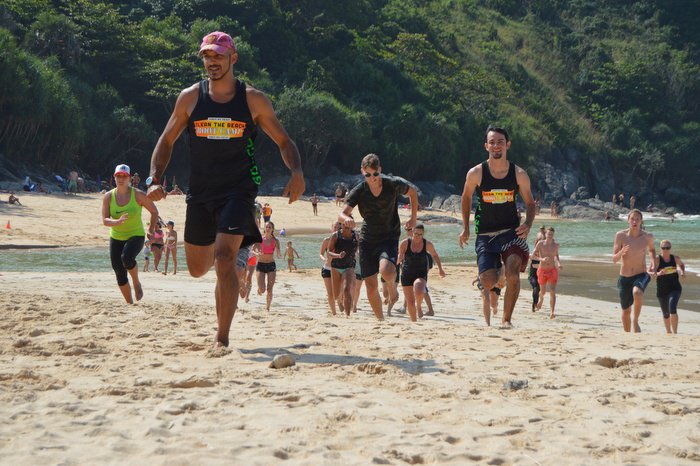Excuse Buster: Bare your soles – The benefits of barefoot training

PHUKET: IT’S hard to complain about life when you’re sweating it out with sand between your toes, the tropical sun on your back and the stunning blue of the Andaman ahead of you. It’s a good thing that barefoot training is catching on and becoming more popular with trainers and coaches.
Many people are aware that barefoot running has been gaining in popularity. However, there are many other sports and activities that are prime for barefoot training, including yoga, gymnastics, dance, muaythai, other martial arts and, my favorite, Clean The Beach Boot Camps.
Training – and even walking – barefoot is something simple that we can do to improve the health of our feet, as well as the rest of our bodies.
Being barefoot is natural. Most of us learned to walk barefoot and spent our childhood running around shoeless. Though we quickly become accustomed to shoes, it is an extremely liberating feeling to be without them. Once we get used to the feeling – again – we naturally love it.
What’s strange, though, is that we have developed a mentality, which is finally being rolled back, that wearing shoes is ‘natural’, and that our feet are fragile and not designed to support us properly. This, of course, isn’t the case – and a fairly silly assumption when you think about it. Of all the footed, pawed and hooved species of the world, why would homo sapiens need shoes? Lest we forget that an enormous number of people all over the world spend their entire lives without ever wearing shoes. Many wander savannas and rain forests without the protection or support of shoes. The reward is strong, healthy feet.
In fact, people who have never worn shoes before have very few foot problems.
Think about it:
1) The foot contains the most proprioceptors (sensors) in the body, so why would we want to deafen the messages to the nervous system by minimizing the amount of information received through our feet?
2) The foot contains 26 bones and 25 joints, which means there is a lot of coordination necessary to have your foot working at optimal efficiency. The foot has to move in all three planes, as it deals with gravity, multiplanar movement, proprioception and dynamic stability. This all becomes hard when we have a barrier between its sensors and the world, such as orthotics, heel lifts and so on.
3) The body recognizes movements, not muscles, so the more we can take the foot to the end of its range of function without pain or discomfort, the better it will react, and the more likely it will allow us to activate our abs – even when we are simply walking.
4) Another advantage is simply that without a shoe on it’s easier to diagnose issues starting with the feet that cause other physical issues, such as knee pain, hip dysfunction or sacroiliac joint (SIJ) pain.
It’s best to liken wearing shoes to how grains and dairy have become incorporated in our diets – these are things recently introduced into our lives and have many potential pitfalls, including, but not limited to, arch pain, arthritis of the foot, bunions, calluses, heel pain and overlapping toes.
On top of this, there are a slew of indirect issues associated with wearing shoes, especially ones that don’t fit properly. These issues can develop in your ankles, knees or hips. They can also develop in your back.
Fashion has seduced many women into cramming their feet into narrow shoes and staggeringly tall stilettos – take a peek at what women are wearing as they trudge along Soi Bangla. The damage from these shoes is very real. I am constantly reminding my female clients about the dangers of high heels. Yes, ladies, they might look good, but they are a surefire way to fan the flames of future health issues caused by progressively shortening and tightening the calf muscles. This can set in motion a chain of events that will effect other parts of your body, such as your back.
Even though shoes might be a certain kind of evil, you don’t want to just kick them off and immediately start running the streets without a care in the world. There are several things to consider.
Firstly, take in your environment. Outside of the obvious – avoid glass walking – be aware that most gyms won’t let you slip out of your trainers. However, they will allow you to train in barefoot shoes, such as Vibram Five Fingers.
Secondly, don’t forget where you’re coming from. If you have engaged in barefoot practices, such as muaythai, in the past, you will probably adapt to other forms of shoeless training faster than someone who has worn shoes their entire life. The bottom line is to listen to your body and take time to adjust to either barefoot shoes or the real deal.
Basically, use common sense. Phuket can be hot – to put it modestly – so avoid freshly baked pavement and shoot for some grass, or for the tide line on the beach.
If you’re not sure if barefoot training is for you, at least kick off your shoes and give it a go with the Clean The Beach Boot Camp – there is no better introduction.
Krix Luther is a fully qualified personal trainer with nearly a decade of experience specializing in strength and conditioning. For more information about Krix and his services, visit krixluther.com
— Krix Luther
Latest Thailand News
Follow The Thaiger on Google News:


























